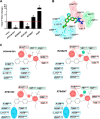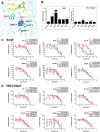Structural Basis for Ligand Recognition and Functional Selectivity at Angiotensin Receptor
- PMID: 26420482
- PMCID: PMC4705918
- DOI: 10.1074/jbc.M115.689000
Structural Basis for Ligand Recognition and Functional Selectivity at Angiotensin Receptor
Abstract
Angiotensin II type 1 receptor (AT1R) is the primary blood pressure regulator. AT1R blockers (ARBs) have been widely used in clinical settings as anti-hypertensive drugs and share a similar chemical scaffold, although even minor variations can lead to distinct therapeutic efficacies toward cardiovascular etiologies. The structural basis for AT1R modulation by different peptide and non-peptide ligands has remained elusive. Here, we report the crystal structure of the human AT1R in complex with an inverse agonist olmesartan (Benicar(TM)), a highly potent anti-hypertensive drug. Olmesartan is anchored to the receptor primarily by the residues Tyr-35(1.39), Trp-84(2.60), and Arg-167(ECL2), similar to the antagonist ZD7155, corroborating a common binding mode of different ARBs. Using docking simulations and site-directed mutagenesis, we identified specific interactions between AT1R and different ARBs, including olmesartan derivatives with inverse agonist, neutral antagonist, or agonist activities. We further observed that the mutation N111(3.35)A in the putative sodium-binding site affects binding of the endogenous peptide agonist angiotensin II but not the β-arrestin-biased peptide TRV120027.
Keywords: G protein-coupled receptor (GPCR); angiotensin; biased ligands; crystal structure; hypertension; protein-drug interaction; sodium ion.
© 2015 by The American Society for Biochemistry and Molecular Biology, Inc.
Figures




References
-
- Zaman M. A., Oparil S., and Calhoun D. A. (2002) Drugs targeting the renin-angiotensin-aldosterone system. Nat. Rev. Drug Discov. 1, 621–636 - PubMed
-
- Balakumar P., and Jagadeesh G. (2014) Structural determinants for binding, activation, and functional selectivity of the angiotensin AT1 receptor. J. Mol. Endocrinol. 53, R71–R92 - PubMed
-
- de Gasparo M., Catt K. J., Inagami T., Wright J. W., and Unger T. (2000) International union of pharmacology. XXIII. The angiotensin II receptors. Pharmacol. Rev. 52, 415–472 - PubMed
-
- Oliveira L., Costa-Neto C. M., Nakaie C. R., Schreier S., Shimuta S. I., and Paiva A. C. (2007) The angiotensin II AT1 receptor structure-activity correlations in the light of rhodopsin structure. Physiol. Rev. 87, 565–592 - PubMed
-
- Burnier M., and Brunner H. R. (2000) Angiotensin II receptor antagonists. Lancet 355, 637–645 - PubMed
Publication types
MeSH terms
Substances
Associated data
- Actions
Grants and funding
LinkOut - more resources
Full Text Sources
Other Literature Sources
Medical
Molecular Biology Databases

